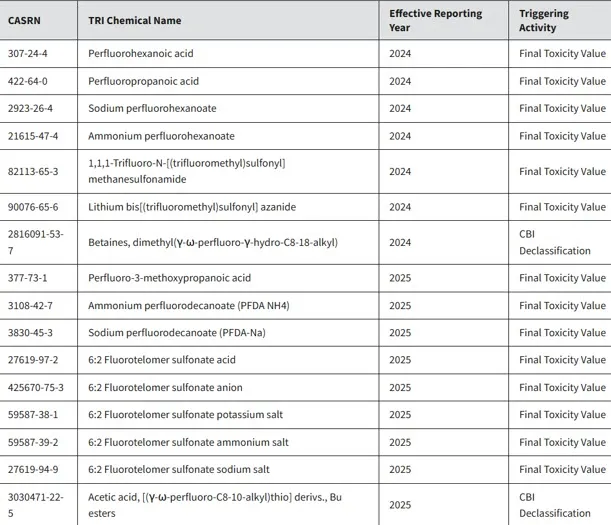Table of Contents
If you’ve read any newspapers or watched any news programs during the last 10 years, you’ve probably heard reports about a class of chemicals called perfluoroalkyl and polyfluoroalkyl substances, more commonly referred to as PFAS or “forever chemicals.” Managing PFAS is more important than ever. But what exactly are PFAS, why are they important, and what do you most need to know about them?
In this post, we’ll provide you with an overview of PFAS, their risks, the regulatory activity surrounding their use, and how those regulations may affect you.
What Are PFAS?
PFAS are a group of synthetic chemicals that have been widely manufactured since the 1940s. The most well-known and frequently studied PFAS are perfluorooctanoic acid (PFOA) which is used in the manufacture of Teflon, and perfluorooctane sulfonate (PFOS), a common ingredient in fabric protectors and stain repellants.
Additional products containing PFAS, and locations where PFAS contamination have been found include:
- Commercial household products, including polishes, waxes, paints, cleaning products, firefighting foams, nonstick products (including Teflon) such as cooking ware, and stain and water-repellant fabrics
- Packaging, including packaging for some food products
- Workplaces that commonly use PFAs including production facilities or industries, such as chrome plating, electronics manufacturing, or oil recovery.
- Drinking water, when locally impacted by specific industries that use PFAS. This is an issue that has understandably attracting a great deal of recent attention.
Why Are People Concerned About PFAS?
Studies of PFOA and PFOS indicate that they can cause reproductive and developmental defects, liver and kidney damage, immunological effects in laboratory animals, and may cause the development of tumors. Findings also consistently show increased cholesterol levels among exposed populations.
There is also limited evidence of a link between PFAS exposure and the following health effects:
- Low infant birth weight
- Effects on the human immune system
- Cancer (for PFOA exposure, specifically)
- Thyroid hormone disruption (for PFOS exposure, specifically)
A further concern is that studies show PFAS are highly persistent in both the environment and in human tissues, meaning that they don’t easily break down and therefore accumulate over time.
One tragic example of the impact of PFAS is the existence of a 25-square mile swath of contamination in Western Michigan resulting from decades of nearby manufacturing activities. According to local news reports, blood test results for one resident of that area showed PFOS concentrations that were approximately 750 times the national average.
What is Being Done About PFAS?
Voluntary phase-outs of PFAS have already occurred, including the PFOA Stewardship Program in which eight major chemical manufacturers agreed to eliminate the use of PFOA and PFOA-related chemicals in their products, as well as emissions of those chemicals from their facilities. Currently PFOA and PFOS are no longer manufactured in the United States, but still enter the country via imports of consumer goods such as carpeting, leather and apparel, textiles, paper and packaging, rubber and plastics.
Growing public concern over PFAS has also prompted EPA to develop its initial PFAS Action Plan in 2019, outlining the steps the Agency is taking to protect the public from PFAS exposure. On April 28m 2025, EPA published an updated version of its plan to address PFAS, which includes actions such as:
- Strengthening the Science— EPA is designating an agency lead for PFAS, implementing a PFAS testing strategy under Toxic Substances Control Act (TSCA), and launching additional efforts on air-related PFAS information collection.
- Enhancing Communication —Developing effluent limitations guidelines (ELGs) for PFAS manufacturers and metal finishers, evaluating other ELGs necessary for reduction of PFAS discharges, addressing the most significant compliance challenges and requests from Congress and drinking water systems related to national primary drinking water regulations for certain PFAS , and determining how to better use RCRA authorities to address releases from manufacturing operations of both producers and users of PFAS.
- Building Partnerships—Advancing remediation and cleanup efforts where drinking water supplies are impacted by PFAS contamination , working with states to assess risks from PFAS contamination and the development of analytical and risk assessment tools, finishing the public comment period for biosolids risk assessment and determining a path forward based on comments , providing assistance to states and tribes on enforcement efforts , reviewing and evaluating any pending state air petitions , and resourcing and supporting investigations into violations to hold polluters accountable .
- Reporting — EPA has already added many specific PFAS to the list of chemicals reportable under Section 313 of the Emergency Planning and Community Right-to-Know Act (EPCRA), otherwise known as Toxic Release Inventory (TRI) or “Form R” reporting. You’ll find more information on TRI/Form R reporting in the next section, since that’s one of the most common regulatory obligations in the US.
- Enforcement —Enforcement spans all of EPA’s current and future regulatory actions related to PFAS, including TRI reporting and holding companies accountable for releases of PFAS to the environment and gaps in managing PFAS.
How Many PFAS are Currently TRI-Reportable?
There are already a large number of PFAS on the list of TRI/Form R chemicals, and the number will only continue growing for the foreseeable future, because there’s a mechanism in place to continue adding new PFAS to the list of TRI-reportable chemicals.
In 2020, Section 7321(b) of the National Defense Authorization Act (NDAA) immediately added certain PFAS to the TRI list and set up a framework for continued addition of new PFAS each reporting year. Reporting requirements became effective on January 1, 2020, and the first reports were due by July 1, 2021 for the initially reportable PFAS (if reporting thresholds were met). It’s a lot easier to meet the reporting threshold, because TRI-reportable PFAS have only a 100-pound reporting threshold, whether it’s processed, manufactured, or “otherwise used.”
For Reporting Year 2024 (reporting forms due by July 1, 2025), the NDAA automatically added seven additional PFAS to the TRI list. The addition of these seven PFAS was codified in a final rule in May 2024, so there are 196 reportable PFAS for RY24. For Reporting Year 2025 (reporting forms due by July 1, 2026), the NDAA automatically added nine additional PFAS to the TRI list. The addition of these nine PFAS was codified in a final rule in January 2025, resulting in 205 TRI-reportable PFAS for RY25. Facilities in TRI-covered industry sectors should begin tracking and collecting data on these chemicals during 2025 as part of their process of managing PFAS. The chart below shows all of the PFAS newly reportable for RY24 and RY25.

Certain EPA activities involving PFAS trigger automatic additions to the TRI list in the future such as finalizing a “toxicity value” for a PFAS. The “effective date” for additions will be January 1 of the year following the activity, and TRI-reportable PFAS will continue to have a 100-pound reporting threshold. These recent PFAS additions to the TRI list underscore the need to have a robust method for identifying PFAS in your chemical inventory and cross-referencing them against the most current form of regulatory lists like EPA’s evolving list of TRI chemicals.
How Does This Affect Me?
As more information becomes available about the extent and health effects of PFAS exposures, and as regulatory scrutiny continues to increase, it’s going to be more important than ever to know exactly how your business will be impacted. As with many other modern chemical management challenges, this is not simply a regulatory issue. Both internal and external stakeholders are demanding greater accountability from corporations with regard to their ability to show they’re managing PFAS risks, as well as risks from other hazardous chemicals.
The essential starting point is knowing whether you have products containing PFAS in your chemical inventory. That means not only having an up-to-date inventory list of all of your chemical products but also having insight into the ingredients of those chemicals, since the name of a product may not necessarily reveal whether it contains PFAS. Visibility of your chemical inventory at the ingredient-level will help you know not only whether PFAS are present in your facilities, but also where they are located and how much is present.
You’ll also need to be prepared to track the movement of certain PFAS through your inventory for the purposes of TRI reporting, especially since EPA will continue adding new PFAS to the list of Form R chemicals each year. Chemical ingredient indexing combined with PFAS identification and regulatory cross-referencing software capabilities can help you accurately identify and track TRI-reportable PFAS using the most recently updated EPA list.
Let VelocityEHS Help!
If you’re looking for support identifying and managing PFAS, we can help.
Our Chemical management solution offers easy management of your chemical inventory and SDS library, with the capability of providing 24/7 access to SDSs for your entire workforce. Ingredient indexing features are even available which make your chemical inventory visible right down to the ingredient level, giving you the ability to know exactly where all of your chemicals are stored, how much is stored, and how much is used. From there, regulatory cross-referencing capabilities provide you with a Levels of Concern (LoC) summary of chemical ingredients on specific regulatory lists, including EPA’s current list of TRI chemicals. Even better, our ingredient indexing features now include a PFAS indicator that identifies PFAS chemicals in your inventory, and so you can have the visibility you need to meet regulatory requirements and make more informed chemical management decisions that protect the safety of your workers and meet stakeholder expectations.
Contact us today to get more information, or to schedule a meeting to see for yourself how Chemical Management can improve your oversight of PFAS and other hazardous chemicals.

